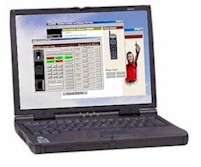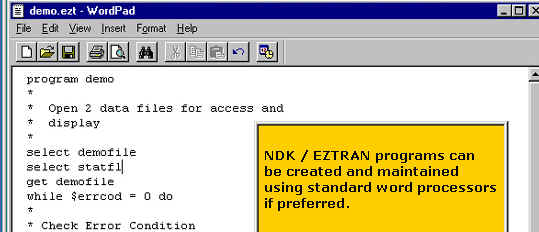|
|
DSC Tech Library
Application Development Toolkit Software
 This section of our technical library presents information and documentation relating to Application Development software and products.
To develop new or upgrade legacy applications for today’s network environments, the NDK components TRANSACT, FASTPlus, EZTRAN, and THIN CLIENT are required as a minimum.
A copy of the THIN CLIENT is required for each PC accessing the final application. The NDK / Server software component can reside on UNIX, LINUX, or a Windows/NT server.
This section of our technical library presents information and documentation relating to Application Development software and products.
To develop new or upgrade legacy applications for today’s network environments, the NDK components TRANSACT, FASTPlus, EZTRAN, and THIN CLIENT are required as a minimum.
A copy of the THIN CLIENT is required for each PC accessing the final application. The NDK / Server software component can reside on UNIX, LINUX, or a Windows/NT server.
EZTRAN - Application Development Language
EZTRAN
replaces traditional programming languages and provides developers with a
simple yet powerful programming tool. Although traditional procedural
languages such as COBOL, FORTRAN, PL/1, and C are available to users of NDK,
EZTRAN has significant advantages over all the previous high level
languages. e.g.; Developers never have to be concerned with migration
incompatibilities to other platforms when using EZTRAN. (Since compilers
vary from platform to platform, the use of EZTRAN completely removes these
annoying issues.) An additional advantage using EZTRAN over other
programming languages is the fact EZTRAN programs/subroutines do not
require its compiled binary be integrated with a “run-time”
executable. This simple fact allows developers to test and debug EZTRAN logic
instantly, thereby saving significant time in the overall development
process. Additionally, unlike traditional methods of developing and
testing applications, EZTRAN does not require a production application be
restarted for debug purposes. As an example of the significance of the
preceding, consider an EZTRAN program that is tested and debugged within a
test bed - then installed on a production version on perhaps another
machine. If the program/subroutine had been created in another language,
the new logic would require the production system be stopped and restarted
to take advantage of the enhancement. (Typically the new logic would not
be available until the following day!) Of course, even with EZTRAN, there
are exceptions to the previous.

TRANSACT’s
complete DML has been incorporated into EZTRAN giving developers a full
complement of data access and manipulation routines without the
constraints associated with programming languages. Programming with EZTRAN
is much easier than with other languages. Simple programs can be entered
and maintained on a full screen within DSC products. For larger programs,
developers can create and maintain EZTRAN programs using a text editor.
EZTRAN programs are compiled using a utility which produces clear and
concise diagnostic messages. These programs can be either stand-alone or can operate within the
entire NDK environment. For example, EZTRAN
programs can be EDIT or INIT routines validating information as it is read
from a screen. Likewise, EZTRAN programs can be invoked from TRANSACT
menus, from TRANSWRITER reports, or even from TRANSPORT systems. EZTRAN
programs are automatically “linked” into DSC software. Thus, the maintenance of EZTRAN programs is
easy.
EZTRAN
is easy to learn and with its use of free-form program input it eliminates many of the
mistakes encountered with traditional programming languages. The language
is completely integrated with all NDK components. It supports screens,
files, menus, formats, and many other elements typically required for
application development. Comprehensive programming constructs including
various program flow control statements are also supported.
Complete
access to the NDK DML (Data Manipulation Library) component also provides
developers with robust capabilities to support even the most complex
requirements. EZTRAN also contains a wide variety of reserved functions
and variables. Other features include;
- Support of graphics.
- Special data formatting capability.
- Complete diagnostic messages during compile.
- Run-time debugging capability.
- Portable across a wide range of computer platforms.
Creating EZTRAN Programs
EZTRAN
programs can be created using the EZTRAN Program Maintenance function.
EZTRAN programs can also be maintained using a standard text editor. Once
created, the program is compiled and automatically cataloged within the
DSC dictionary.
EZTRAN Program Structure
An
EZTRAN source program is a very simple structure. All commands are free
form. Programs contain statements for declaring any local or global
variables, program control statements, and EZTRAN action commands. By
simply selecting a file or by invoking a screen, developers have complete
access to the dictionary definitions of the file or screen fields. Program
flow statements include IF THEN ELSE logic, WHILE constructs, as well as
loop control using the FOR and NEXT operations. EZTRAN action commands
include over 150 statements inclusive of the entire DSC DML.
|


 This section of our technical library presents information and documentation relating to Application Development software and products.
To develop new or upgrade legacy applications for today’s network environments, the NDK components TRANSACT, FASTPlus, EZTRAN, and THIN CLIENT are required as a minimum.
A copy of the THIN CLIENT is required for each PC accessing the final application. The NDK / Server software component can reside on UNIX, LINUX, or a Windows/NT server.
This section of our technical library presents information and documentation relating to Application Development software and products.
To develop new or upgrade legacy applications for today’s network environments, the NDK components TRANSACT, FASTPlus, EZTRAN, and THIN CLIENT are required as a minimum.
A copy of the THIN CLIENT is required for each PC accessing the final application. The NDK / Server software component can reside on UNIX, LINUX, or a Windows/NT server.
